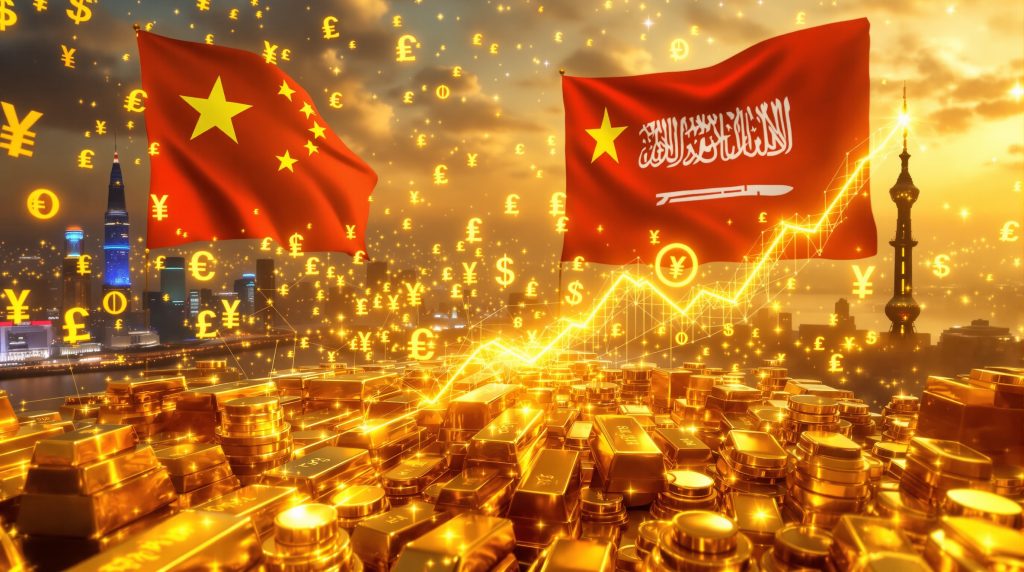Yuan-Gold Trading: China's Strategy to Reshape Global Finance
China has been making significant strides in internationalizing its currency through a strategic gold trading system that creates new pathways for global commerce. By establishing direct yuan-gold convertibility mechanisms, China is gradually building an alternative financial infrastructure that could reshape international trade settlements.
The Shanghai Gold Exchange's Global Expansion
The Shanghai Gold Exchange (SGE), founded in 2002, has evolved into the world's largest physical gold exchange by trading volume. China's dominance in this sector isn't surprising given its position as both the largest gold producer (since 2007) and consumer (since 2013), according to World Gold Council data.
The SGE has strategically expanded beyond mainland China's borders, establishing international presence that enables physical gold trading denominated in yuan. While specifics about certain international vaults require verification through official sources, the exchange's international board (SGEI) launched in 2014 represents a clear move toward global integration.
This network creates an infrastructure allowing yuan-denominated trades to be settled with physical gold delivery, establishing alternatives to traditional dollar-based settlement systems.
What Makes the Yuan-Gold Trading System Revolutionary?
The yuan-gold trading system represents a significant innovation in international finance by creating pathways for trade settlement outside traditional Western-dominated systems. This approach differs from historical gold standards by offering flexibility rather than rigid currency-gold pegging.
Gold-Backed Instruments in Financial Markets
A key component of this system involves gold-backed financial instruments that can function within the broader financial ecosystem. The Shanghai Gold Exchange offers various gold-backed products that provide liquidity and financial utility.
This approach creates mechanisms where gold's inherent value can support financial transactions without the constraints of a traditional gold standard. Such instruments potentially provide alternative options for financial institutions seeking to diversify collateral options.
Digital Settlement Infrastructure
China has been developing comprehensive digital payment infrastructure to support cross-border transactions. The Bank for International Settlements (BIS) has documented various multi-CBDC bridge projects aimed at improving cross-border payments efficiency, though specific claims about participant numbers and operational details require verification through official sources.
This digital architecture aims to create more efficient cross-border settlement options, potentially reducing transaction costs and settlement times for international trade.
How Does Saudi Arabia Factor Into China's Financial Strategy?
Saudi Arabia represents a strategically important partner in China's expanding financial architecture, particularly given its position as a global energy producer and regional economic power.
Energy-Finance Connections
Saudi Arabia's relationship with China has been evolving significantly in recent years, with energy trade forming a cornerstone of bilateral relations. In 2023, bilateral trade between China and Saudi Arabia reached approximately $87 billion, according to official trade statistics, with energy products comprising a significant portion.
Saudi Arabia's Vision 2030 economic diversification plan explicitly mentions expanding international partnerships beyond traditional Western allies, aligning with its strategic hedging as global power dynamics evolve.
Changing Regional Dynamics
The Middle East's geopolitical landscape has been shifting, with countries increasingly adopting multi-aligned foreign policies rather than exclusive partnerships. Saudi Arabia has been diversifying its economic and security relationships, reflecting pragmatic adaptation to changing global power distributions.
This realignment creates opportunities for new financial arrangements, including potential expanded use of yuan-denominated instruments in regional trade settlement.
What Are the Key Components of China's Emerging Financial Architecture?
China's approach to developing alternative financial pathways involves multiple interconnected elements that collectively create a comprehensive system for international trade and investment.
China's Expanding Bond Market
China's bond market has grown substantially, reaching approximately $19.9 trillion as of end-2023 according to Bank for International Settlements data, making it the world's second-largest after the United States. This growth reflects deliberate policy efforts to deepen financial markets and enhance the yuan's international role.
The "panda bond" market—yuan-denominated bonds issued by foreign entities in China—has shown notable development, with multiple sovereign and corporate issuers. Hungary, for instance, has issued yuan-denominated bonds, though specific amounts and timing should be verified through official Hungarian government sources.
This expanding debt market provides alternatives to dollar-denominated financing for international projects, creating more options for capital raising and investment. Understanding these gold bond dynamics is crucial for investors navigating this evolving landscape.
Energy Infrastructure Connections
Energy trade forms a crucial component of China's international financial strategy, with infrastructure developments creating long-term trade relationships that reinforce financial ties.
China has been systematically developing energy import diversification through pipeline networks with multiple partners. These physical infrastructure connections create long-term trade relationships that naturally support expanded use of yuan-denominated settlement.
Energy-finance integration creates mutually reinforcing systems where physical trade flows support financial architecture development, particularly in regions with significant energy production capacity.
How Does Yuan-Gold Trading Impact Global Financial Stability?
The emergence of alternative financial settlement options has potential implications for global monetary stability and market operations, though these effects are likely to unfold gradually rather than abruptly.
Central Bank Reserve Diversification
Central banks globally have been increasing their gold holdings, with World Gold Council data showing consistent net purchases over recent years. This trend reflects a broader interest in diversification of reserve assets beyond traditional currency holdings.
While claims that central banks collectively hold more gold than US Treasuries would require verification through comprehensive reserve composition analysis, the direction of diversification is clear in official reserve statistics. The latest gold prices analysis shows how this trend continues to influence global markets.
This gradual evolution of reserve asset preferences reflects risk management strategies by monetary authorities seeking to balance stability concerns with return requirements in an evolving global monetary landscape.
Incremental Financial Evolution
China's approach to developing alternative financial mechanisms has been characterized by gradualism rather than disruptive changes. This measured strategy aims to avoid financial market instability while building parallel structures.
This incremental approach allows for system testing and refinement while minimizing market disruption, creating space for organic adoption rather than forced implementation.
Market Insight: Financial systems typically evolve through accumulation of incremental changes rather than revolutionary breaks, allowing participants time to adapt operational systems and risk management approaches to new realities.
What Are the Implications for Western Financial Dominance?
The development of alternative financial mechanisms presents both challenges and opportunities for the existing international monetary system dominated by Western institutions since the mid-20th century.
Diversifying Settlement Options
The expansion of alternative settlement mechanisms potentially reduces the systemic importance of traditional dollar-based systems for certain trade relationships. This evolution creates more options for international trade participants rather than replacing existing systems entirely.
This diversification may gradually reduce the network effects that have reinforced dollar dominance in international trade, though such changes typically unfold over decades rather than years. The US-China trade war impact has accelerated some of these trends in recent years.
Changing Financial Center Geography
Financial activity naturally concentrates around centers that efficiently serve major trade flows. As trade patterns evolve, financial services tend to follow, creating opportunities for new or expanded financial centers.
Economic activity increasingly shifting toward regions participating in these new financial structures could gradually reshape the geography of global finance, though established financial centers retain significant advantages in expertise, regulatory frameworks, and network effects.
How Does This Compare to the 1970s Petrodollar System?
The yuan-gold trading system shares some functional similarities with the petrodollar system established in the 1970s, though with notable differences in structure and implementation approach.
Historical Comparison Points
The petrodollar system emerged from specific agreements between the US and Saudi Arabia in the 1970s, creating mechanisms for recycling oil export revenues through US financial markets. This arrangement helped stabilize the international monetary system following the end of the Bretton Woods gold standard.
China's approach appears more flexible and multilateral, focusing on providing infrastructure and mechanisms rather than exclusive currency arrangements. This flexibility potentially makes the system more adaptable to diverse participant needs.
Structural Distinctions
Unlike the petrodollar system's relatively centralized structure, China's approach emphasizes technological infrastructure enabling multiple currencies to interact through standardized protocols. This architecture potentially allows for greater diversity within a common framework.
The integration of physical gold convertibility provides a distinctive confidence-building mechanism not present in the petrodollar system, potentially addressing trust concerns that might otherwise limit adoption. Many analysts see this as a gold strategic investment by China to gain global financial influence.
What Does the Future Hold for Yuan-Gold Trading?
The continued evolution of yuan-gold trading systems will likely depend on multiple factors, including technological development, geopolitical conditions, and market participant preferences.
Potential Expansion Pathways
The gold-backed yuan settlement mechanism could potentially expand beyond energy to other commodity categories, including agricultural products, industrial metals, and critical minerals. This expansion would broaden the system's utility and network effects.
Integration with broader trade initiatives could create reinforcing networks where financial architecture and physical trade flows mutually support each other's development. According to a recent South China Morning Post report, China plans to boost yuan overseas gold storage facilities as part of this strategy.
Challenges and Limitations
Despite its strategic potential, the system faces several practical challenges:
- Trust-building requirements with diverse international participants
- Technological infrastructure development and security concerns
- Regulatory harmonization needs across diverse jurisdictions
- Competition from established systems with strong network effects
These factors will influence adoption rates and ultimate impact on global financial structures.
FAQ: Yuan-Gold Trading System
Is China creating a new gold standard?
No, China is not establishing a traditional gold standard where its currency is fully backed by and redeemable for gold at fixed rates. Instead, it is creating convertibility mechanisms that allow yuan holders to exchange for physical gold through the Shanghai Gold Exchange, providing confidence in the yuan without the rigid constraints of a formal gold standard.
How might this affect global gold prices?
The system could potentially create additional demand channels for physical gold, supporting prices over time. However, effects would likely be gradual rather than sudden, as the system appears designed primarily for settlement rather than accumulation. The gold price forecast for coming years suggests continued strength regardless.
Can other countries participate in this system?
Yes, the system appears designed to allow participation from other nations, particularly those involved in substantial trade relationships with China. Countries can potentially utilize the clearing infrastructure while maintaining their own currencies for domestic purposes.
Does this mean the US dollar will lose its reserve currency status?
No immediate displacement of the dollar is likely. International monetary systems typically evolve gradually rather than through sudden replacements. The dollar will continue to play a significant role in global finance, though potentially with evolving scope as alternatives develop.
How does digital currency technology factor into this system?
Digital currency technology enables more efficient cross-border settlement without traditional banking intermediaries. Various international CBDC experiments demonstrate growing interest in these capabilities across major economies.
Understanding Broader Context
Yuan-gold trading represents one element of a complex, evolving international monetary landscape. Multiple factors beyond any single mechanism—including trade relationships, financial market depth, regulatory frameworks, and geopolitical conditions—will collectively shape the international monetary system's future development.
Financial systems tend to evolve through incremental adaptations rather than revolutionary breaks, with new mechanisms often coexisting with established ones for extended periods before clear patterns emerge. This evolutionary process allows participants to adapt gradually while maintaining necessary stability for economic activity.
Disclaimer: This analysis represents current understanding of evolving financial systems and should not be interpreted as investment advice. Future developments may differ significantly from current expectations due to the complex interplay of economic, technological, and geopolitical factors.
Are You Prepared For The Next Major Mineral Discovery?
Don't miss out on significant market returns from ASX mineral discoveries by relying on outdated information. Discovery Alert's proprietary Discovery IQ model delivers instant notifications on major discoveries, turning complex mineral data into actionable insights for both short and long-term investors. Understand why historic discoveries generate substantial returns by visiting the Discovery Alert discoveries page and begin your 30-day free trial today.




